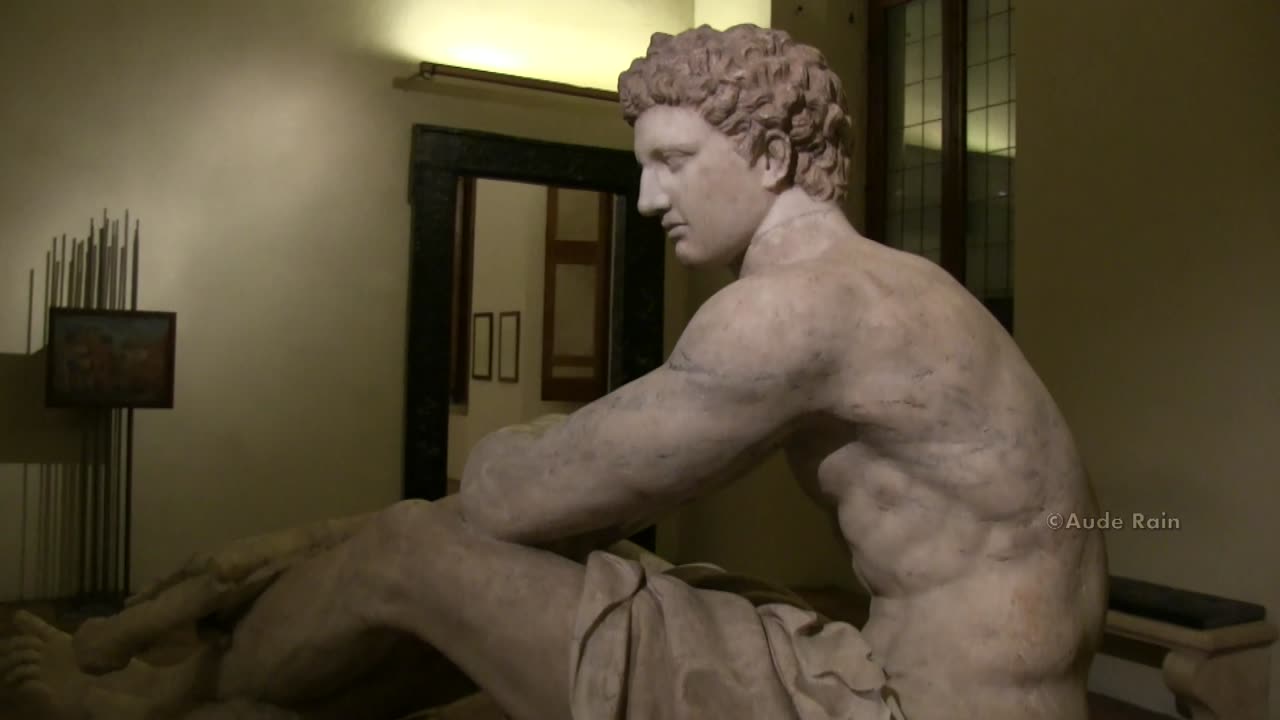Premium Only Content

Guerriero seduto & Ares Ludovisi
Young warrior sitting on the ground, pendant of the Ares Ludovisi. Pentelic marble (body) and Parian marble (head), Roman copy from a Hellenistic original. Some restorations; the head (of the type of Meleager of Skopas) is ancient, but does not belong to the body.
Ares Ludovisi
Realization: 200 BC
"It is a Roman copy of a Greek original attributed to Scopas or Lysippus dating back to around 320 BC. The identification of the figure, traditionally considered the god of war, remains doubtful. Recently the hypothesis has been put forward that it is Achilles. The man is seated with his weapons laid down: he rests his left foot on his helmet, while his shield rests on his right leg. Found in 1622, it owes part of its fame to the restoration by Gian Lorenzo Bernini who, among other interventions, added the little cupid at the bottom.
The famous archaeologist Winckelmann defined the statue as "the most beautiful Mars of antiquity"."
Filmed at Palazzo Altemps and at the Galleria Borghese in Rome.
Giovane guerriero seduto a terra, pendant dell'Ares Ludovisi. Marmo pentelico (corpo) e marmo pario (capo), copia romana da un originale ellenistico. Alcuni restauri; la testa (del tipo del Meleagro di Skopas) è antica, ma non appartiene al corpo.
Ares Ludovisi
Realizzazione: 200 a.C.
È una copia romana di un originale greco attribuito a Scopa o a Lisippo databile intorno al 320 a.C. Resta dubbia l’identificazione della figura, tradizionalmente considerata il dio della guerra. Recentemente è stata avanzata l’ipotesi si tratti di Achille. L’uomo è seduto e con le armi deposte: poggia il piede sinistro sul suo elmo, mentre sulla gamba destra è poggiato il suo scudo. Rinvenuto nel 1622, deve parte della sua fama al restauro di Gian Lorenzo Bernini che, tra gli altri interventi, aggiunse il piccolo amorino in basso.
Il celebre archeologo WInckelmann defini la statua «il più bel Marte dell’antichità».
-
 59:57
59:57
The StoneZONE with Roger Stone
6 hours agoJ6 Martyr Enrique Tarrio Describes Inhumane Prison Conditions Ordered by Biden | The StoneZONE
30.4K2 -
 16:48
16:48
Tundra Tactical
6 hours ago $1.15 earnedAffordable Medical Gear From ACETAC SHOT Show 2025
28.2K2 -
 1:46:16
1:46:16
Redacted News
9 hours agoRFK CONFIRMATION: Kennedy goes to WAR with Big Pharma Democrats in Fiery Hearing | Redacted Live
220K413 -
 57:31
57:31
Candace Show Podcast
9 hours agoBREAKING! Taylor Swift Turns Against Blake Lively & Ryan Reynolds | Candace Ep 141
205K200 -
 1:04:59
1:04:59
Sarah Westall
6 hours agoRFK Jr Report, Constitution Suspended, War Time Procedures in Place, WHO Exit, DOD w/ Sasha Latypova
57.7K32 -
 1:56:37
1:56:37
Melonie Mac
10 hours agoGo Boom Live Ep 35!
54K13 -
 1:01:13
1:01:13
LFA TV
13 hours agoPRESIDENT TRUMP SIGNS LAKEN RILEY ACT | BASED AMERICA 1.29.25 6pm
62.8K7 -
 1:43:07
1:43:07
2 MIKES LIVE
7 hours ago2 MIKES LIVE #172 News Breakdown Wednesday!
30.9K2 -
 1:26:16
1:26:16
The Big Mig™
8 hours agoJ6’r Ryan Samsel Free At Last The BOP & DOJ Exposed
30.8K3 -
 31:34
31:34
The Based Mother
8 hours ago $1.58 earnedEXECUTIVE ORDER MUTILATES GENDER IDEOLOGY! Trump’s pulling out all the stops.
20.2K8